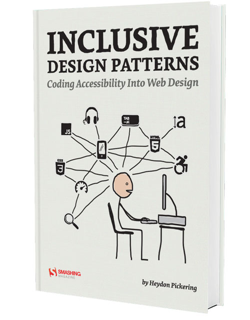This week Heydon Pickerings’ Inclusive Design Patterns came out. As I was quite fond of his previous work, I insta-bought the ebook version (hard copy will be available from October).
The book does not (only) show you how to write front-end code in an accessible manner, it teaches you how to think like an inclusive designer. That is, a designer that considers the widest range of people possible. Heydon does go into the code involved, but that is mostly in support of the inclusive thinking he advocates.

It’s all about making things work for people
The book shows why creating accessible websites is not a ’bureaucratic box-ticking’ exercise (IDP, 121). It’s not just a matter of slapping on the right ARIA attributes, it is all about envisioning what would give people the best way to experience your site. Designing the best way for people to use your thing. If ARIA helps with that, fine. However, Heydon warns, never fix something with JS and ARIA if it could be done with HTML and CSS.
Inclusive design, says Heydon, has this as its object: ‘the user’s ability to actually get things done’ (IDP, 121; emphasis his). Throughout the book, it becomes apparent that making a product accessible is not a matter of always doing X or always doing Y. You have to always consider (and then test) what works best, has wide browser support and gives the best results.
Inclusive Design Patterns is full of interesting things, like how to use Schema to make search results for your site more accessible, what screen readers voices say and how to tweak that, and giving users feedback on form input with live regions. It contains many real world examples, like filter widgets and ‘Load more’ interactions. Clever ways of making things work. There really is something to be learned for everyone in this book. Highly recommended! (Buy the ebook)
Comments, likes & shares
No webmentions about this post yet! (Or I've broken my implementation)